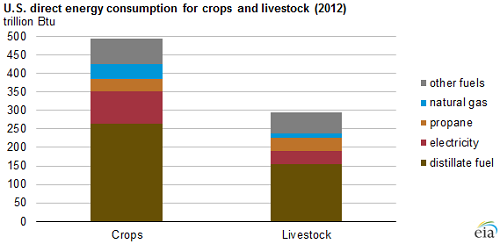Farmers are using… but also making… a lot of energy. A new report from the U.S Energy Information Administration shows that American agriculture used nearly 800 trillion British thermal units (Btu) of energy in 2012, or about as much primary energy as the entire state of Utah. While growing and harvesting the crops and the energy needed to raise livestock are significant expenditures (with crop operations consume much more energy than livestock operations), those same farms are also big contributors to our nation’s fuel supply.
Energy makes up a significant part of operating expenditures for most crops, especially when considering indirect energy expenditures on fertilizer, because the production of fertilizer is extremely energy-intensive, requiring large amounts of natural gas. For some crops like oats, corn, wheat, and barley, energy and fertilizer expenditures combined make up more than half of total operating expenses. The proportion of direct to indirect energy use varies by crop. For example, corn, which is also used as an energy input for ethanol production, has relatively low direct fuel expenditures but has the highest percentage of fertilizer expenditures.

The energy consumed in livestock operations is almost solely direct energy consumption and is relatively low compared with crop operations, both as a percentage of total operating expenditures and on a total energy basis…
In addition to being major energy consumers, some farms are using renewable resources to produce energy. Wind turbines, methane digesters, and photovoltaics are the most common on-farm renewables. Renewable energy can help to offset the need for purchased energy. In some cases, the renewable energy produced on farms is sold to electric power suppliers, providing additional income for farmers.
The report also says that water and chemicals used in agriculture can be big users of energy resources.

